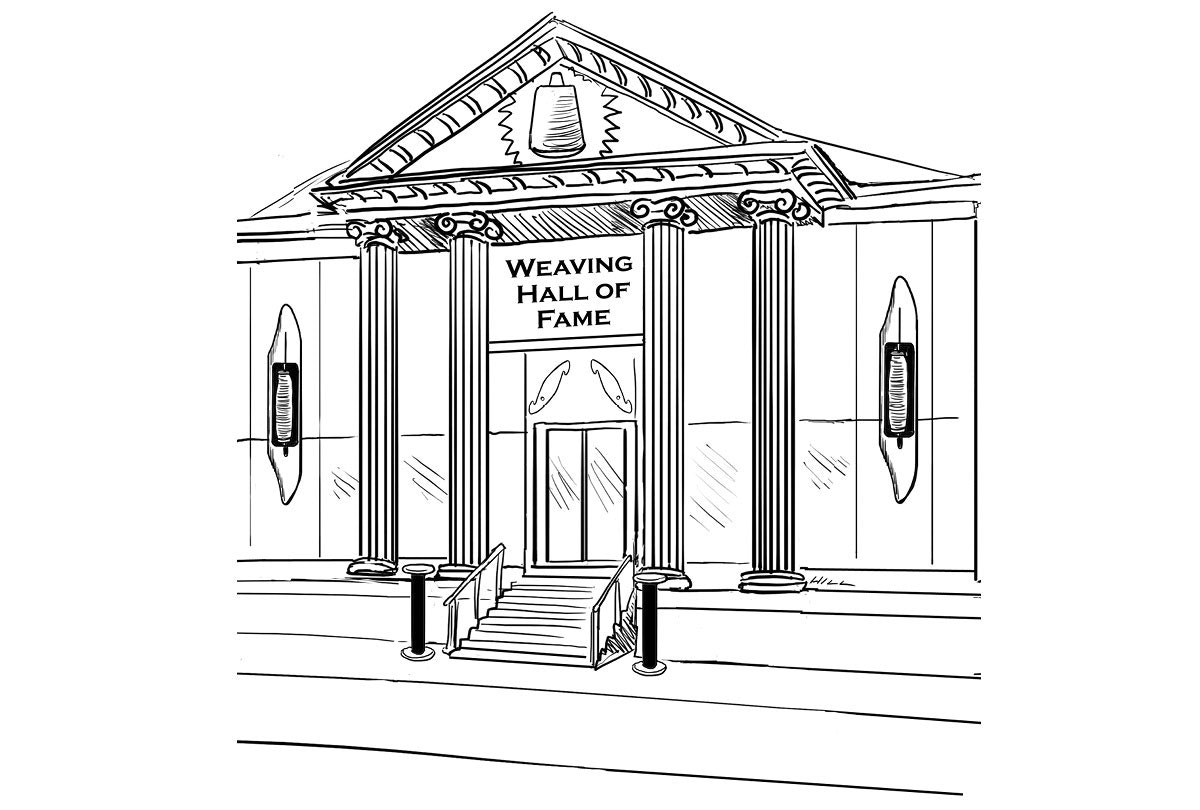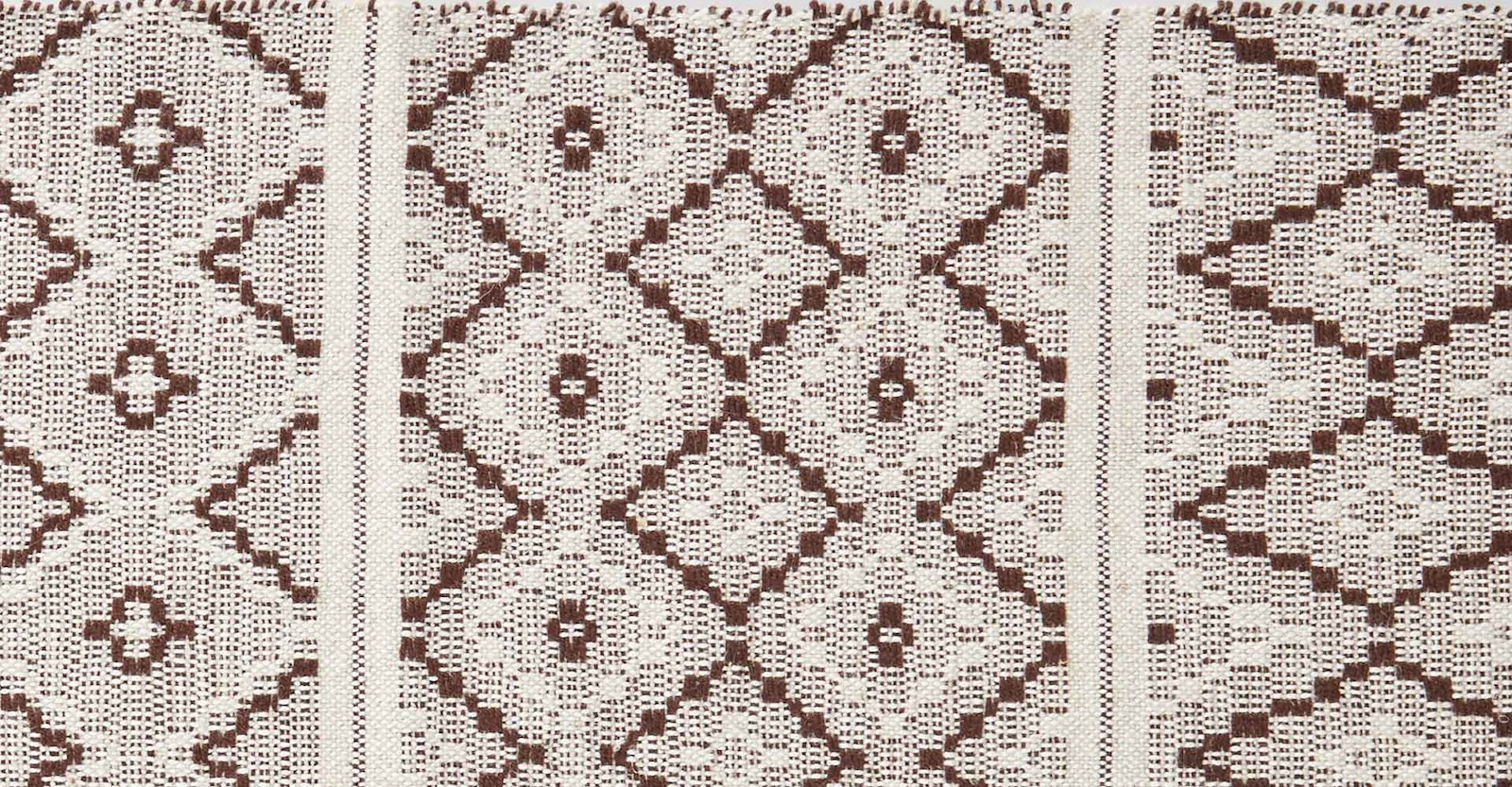Last year, when my husband was inducted into the New Jersey Softball Hall of Fame, I started thinking about the Hall of Fame as a concept. Granting membership is a way to honor the elite few, the extraordinary athletes, musicians, and other professionals whose achievements are remarkable. As I thought more about this, I asked myself, why not open the doors of a Hall of Fame for those achievements that are often overlooked? My thoughts immediately turned to weaving. How about a Weaving Hall of Fame?
Weaving is such an ancient, timeless craft that selecting nominees needs a different approach. Some of our greatest textile achievers are anonymous, lost in the thousands of years of weaving that stretch back beyond recorded history. We can’t research their biographies.
As the self-appointed Director of the Weaving Hall of Fame, I nominate those innovators who pushed weaving past the status quo of their time. Back in prehistory, there must have been a first someone who saw beyond the over and under of plain weave. It may have even been a radical idea to go over and under multiple warp ends for each pick.
The Great Unknowns
My first nominee is the unknown person who gave us twill. If I had been a weaver in the dusty past, would I have thought of weaving twill? Probably not. Heck, I’m sure I wouldn’t even have thought up a multishaft loom. Speaking of, while there have been many versions of looms over the ages, I want to thank, and nominate, the unknown person who gave us the multishaft loom. A four-shaft loom is modest by today’s standards, but our early New Stone Age weaving ancestors would have been awestruck by this invention.
Next up is the weaver who invented doublewidth weaving. When I take my folded 30-inch piece of weaving off the loom and open it to its full 60-inch width, it always feels as if a weaving miracle has occurred. Even after a lifetime at the loom, I never would have come up with the notion of loom, I loom, I never would have come up with the notion of doublewidth weaving. I salute the weaver who figured out how to push past the limitation of a loom’s width.
Whoever came up with the idea of the floating selvedge also belongs in my Weaving Hall of Fame. Like many brilliant ideas, the concept is simple yet so effective. As a beginning weaver, I thought I was doing something wrong when the selvedge warp ends didn’t catch. I’m reserving a place for the person who figured out how to keep our selvedges tidy.
I started with this initial selection of innovators out of gratitude. Without their ingenuity, I might still be tediously picking my way over and under across each row. I might actually hate weaving. Each new way of manipulating thread formed the foundation of our modern weaving world. It is on this foundation built by those nameless ancestral fiber pioneers that our modern trailblazers have continued pushing the “weaving envelope.”
Modern Allstars
Our modern nominees are no longer nameless weavers. They are part of our weaving infrastructure and have become household names for many of us. A weaving library would not be complete without their books.
It’s time we honored Marguerite Porter Davison with a place in the Weaving Hall of Fame. Davison self-published A Handweaver’s Pattern Book in 1944. To weavers, it is also known as the “Green and Yellow Book,” and it is a treasury of almost 400 four-shaft weaving drafts. Through her research, Davison discovered and preserved drafts for long-forgotten fabrics.
According to Amazon, Deborah Chandler’s book Learning to Weave has sold more than 150,000 copies, one of which was mine. The book starts with the assumption that the reader knows absolutely nothing about weaving. Deborah’s friendly style of writing, along with clear drawings and excellent photos, makes warping and weaving an understandable process. She breaks processes down to simple components that make it possible to learn to weave without an actual teacher, class, or YouTube video. She was also a founding member of Weave a Real Peace (WARP). In 1999, she moved to Guatemala and became the director of Mayan Hands, a fair-trade organization providing a way for Mayan women weavers to earn a living though their weaving. Welcome, Deborah, into the Weaving Hall of Fame.
Have you ever gotten lost during an instructor’s explanation of a weaving draft? I have, and I don’t think I’m alone. I have heard that my next nominee, Carol Strickler, could simply look at a draft and see a mistake, the perfect skill for her stint as Handwoven technical editor. Many personal weaving libraries include her book A Weaver’s Book of 8-Shaft Patterns. To explore the possibilities for using different weave structures, 266 weavers wove samples and sent in drafts for her book. If you need inspiration, you’ll always find it here.

Illustration by Mark Hill
.My guild tried to appoint a “Weaving Wizard” at each meeting to answer questions from new weavers. No one ever wanted this title. Even experienced weavers felt insecure about their knowledge. If Madelyn van der Hoogt had been a member of the guild, we wouldn’t have had this problem. She is the world’s Weaving Wizard. As former editor of Prairie Wool Companion, Weaver’s, and Handwoven, she has long been a star in our weaving universe. We read her magazine articles, watch her videos, buy her books, and attend her weaving school, all in the quest to acquire her knowledge. This may take some of us a few lifetimes. Congratulations, Madelyn!
Our last nominee has done the impossible. For modern American handweavers, weaving and sewing have not always been the best of friends. Daryl Lancaster changed that. She has crisscrossed the country offering workshops in garment construction. Her “Daryl” jacket, made from a custom-fitted pattern, hangs in many of our closets. She is there to support us with workshops, webinars, and monographs on sewing with handwoven cloth, and inspires us with her own wearable art. Through her keynote speeches, workshops, personal awards, and published work (see page 18), many of us feel as if we know her. I think we can agree that she belongs in the Weaving Hall of Fame.
Already I can hear my fellow weavers loudly offering their own suggestions for our hallowed hall. Yes, there are many more who deserve this honor, but I have chosen these nominees for a reason. Their contributions to my personal weaving world are as much a part of my weaving as the fiber I use. So, as I officially induct them into my Weaving Hall of Fame, I want to personally thank each one for helping me discover the joy of this ancient craft.
Resources
- Chandler, Deborah. Learning to Weave. Loveland, Colorado: Interweave Press, 1995.
- Davison, Marguerite Porter. A Handweaver’s Pattern Book. Swarthmore, Pennsylvania: Marguerite P. Davison, 1944.
- Strickler, Carol. A Weaver’s Book of 8-Shaft Patterns. Loveland, Colorado: Interweave Press, 1991.

